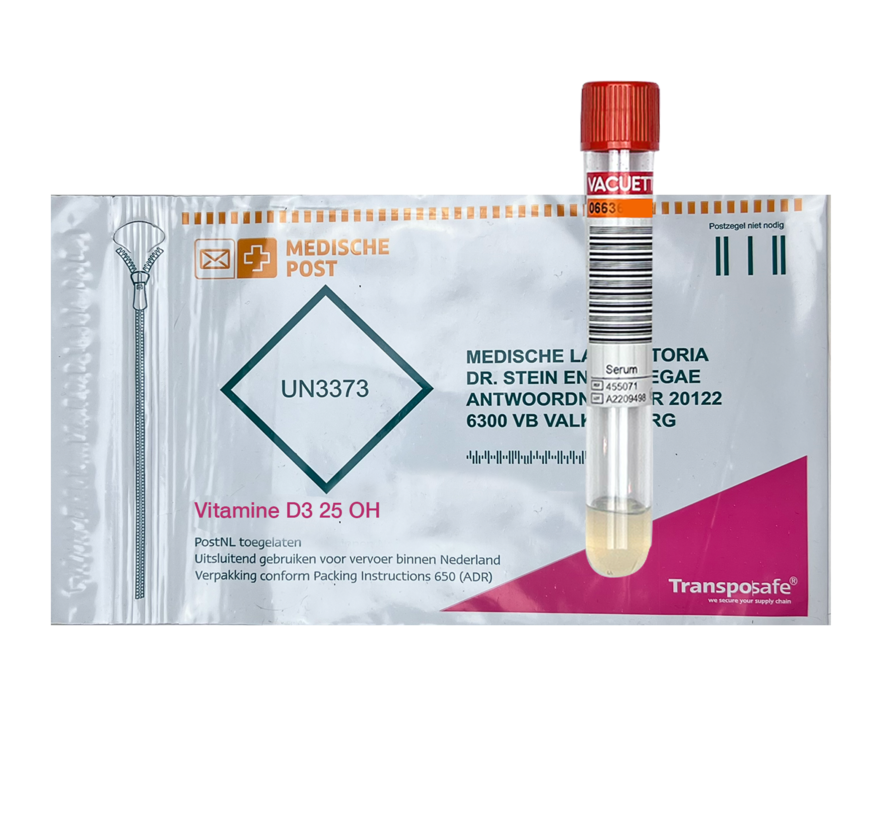Vitamin D3 Deficiency? 25-OH vitamin D level
Vitamin D3, 25-OH Test
Vitamin D is important for the human body. It makes bones stronger and has a positive effect on mood.
However, many people suffer from a vitamin D deficiency. They eat too few foods containing this vitamin and have too little contact with sunlight. Vitamin D can not only be ingested, it can also be produced in the body under the influence of sunlight. A lack of vitamin D can weaken the bones. It can also lead to a depressed mood.
This test measures the amount of vitamin D in blood. Two different forms occur in the blood: the active form 1,25-dihydroxy vitamin D and the non-active form 25-hydroxy vitamin D that serves as a stock for the active form.
Vitamin D, is one of the few vitamins that our body can make itself. Under the influence of sunlight (ultraviolet radiation) vitamin D is formed in our skin and converted into an active form in the liver and kidneys. However, these amounts are not sufficient for all people, nor under all circumstances. Therefore, we often need additional vitamin D from our diet. In fatty fish such as eel, herring, salmon, mackerel and broccoli, for example, there is a lot of vitamin D.
Vitamin D is needed for strong bones and teeth. It ensures that calcium and phosphate from our food are absorbed and during growth can be deposited in our bones, teeth and molars. In addition, vitamin D is needed to minimize osteoporosis.
Some people do not come out in the daylight or hardly at all, for example night workers, people with dark skin tones or people who cover their skin completely. They are at risk of vitamin D deficiency.
Lowered:
A low vitamin D in the non-active form (25-hydroxy vitamin D) indicates a vitamin D deficiency. This can be caused by too little sunlight, inadequate dietary intake, or poor absorption from the intestines. Low vitamin D in the active form (1,25-dihydroxy vitamin D) can occur with kidney disease. The use of some drugs for epilepsy can lead to a less well-functioning liver so that it makes less vitamin D. Magnesium levels that are too low can lead to decreased calcium levels. The body cannot restore this with the help of vitamin D and parathyroid hormone (PTH). After administration of magnesium and calcium, regulation is restored.
Vitamin D is produced in the skin, however, sunlight must have a certain intensity. If the shadow of the body is longer than the actual body length, the body is no longer able to produce vitamin D itself. In addition, vitamin D can be extracted from food (fatty fish, shiitake mushrooms, egg yolk, as additives in margarine and cooking fats) or from vitamin D pills. The variant from plants is the D2 variant but is converted to the active metabolite in the body just as much as the D3 from animals. As an indication of the relationship between vitamin D intake (cholecalciferol) and the measured concentration, approximately 1 microgram/day for each nmol/l increase can be used. To go from 50 to 80 nmol/l 25(OH)D is about 30 micrograms of cholecalciferol per day for at least two months.
Below a 25(OH)D serum concentration of 20 nmol/l, the risk of rickets and osteomalacia is greatly increased (multiple publications).
- Muscle pain and complaints occur at concentrations < 20 nmol/l (ref. Torrentes de la Jara), whereas muscle weakness and an increased risk of falling occur at concentrations < 50 nmol/l (Janssen/Verhaar, Lips, Bischoff-Ferrari).
- Bone density drops significantly at values < 50 nmol/l (e.g. Bischoff-Ferrari).
- By aiming for a minimum level of 75-80 nmol/l, gains can be made through risk reduction for several types of cancer and for autoimmune diseases (Dawson-Hughes, Biscchoff-Ferrari et al.)
- One must go to even higher values (> 100 nmol/l) for special results such as reducing the incidence of seizures in MS.
- Up to a concentration of about 220 nmol/l there is no danger of excess calcium.
Increased:
High vitamin D in the non-active form (25-hydroxy vitamin D) usually means that a person is getting too much vitamin D, such as through vitamin pills or other supplements. A high vitamin D in the active form (1,25-dihydroxy vitamin D) may come from excessive production of parathyroid hormones or in diseases such as sarcidosis or some lymphomas.
High vitamin D (concentrations above 250 nmol/l) combined with elevated calcium can cause calcification and damage to organs such as the kidneys. The body tries to lower the amount of calcium by depositing calcium phosphate in the organs. This causes the organs to calcify and become damaged.
How do you solve a vitamin D3 deficiency?
First a blood test where the D3 is measured. If this is below the minimum value of 80 nmol/l, it is wise to take a supplement. If the value is below 40 nmol/l then it is advisable to ask the doctor for Cholecalciferol, this is a liquid form D3 in high doses and is reimbursed by the health insurance company.
It is important to regularly measure the D3 value so you do not get too high a level.
Also read our blog: https://info.bloodtesting.nl/jouw-vitamine-d-spiegel-hoog-genoeg/










